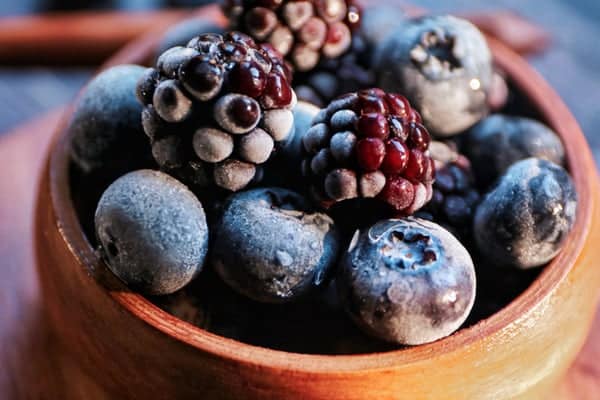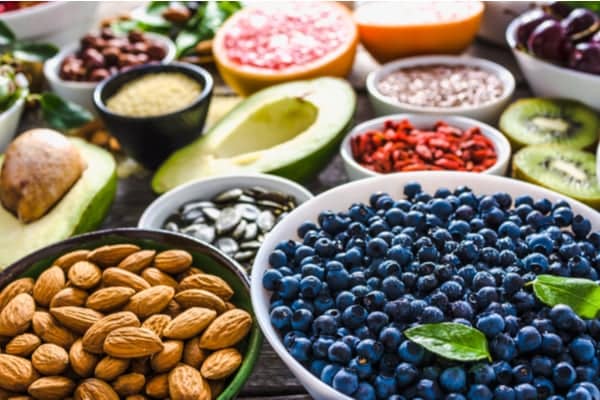Are you looking for some inspiration to add a little variety to your plant-based meals?
Canned black beans are a convenient go-to plant-based source of protein that is relatively easy to find in most grocery stores. However, there are dozens of different types of beans and legumes you can add to your personal ingredient rotation and recommend to your coaching clients when discussing nutrient-packed choices.
Here are some of the benefits of eating more pulses in the diet:
- They are generally low-cost, especially if they are produced in the region in which you live. They also have a long shelf-life. These qualities can help support food security.
- Different varieties of pulses often have a vital place in cultural foods from around the world.
- They are environmentally sustainable foods; their cultivation helps to reduce greenhouse gases, improve soil fertility, and nourish crops that grow alongside them.
- There are hundreds of varieties of pulses. Trying new types is a great way to shake things up in the kitchen!
In this article, we give you an overview of 9 of the most nutritious beans, pulses, and legumes you might not have heard of. In addition to talking about their nutritional content, we also introduce you to their historical background and some culturally relevant applications.
What Is the Difference Between Beans, Legumes, and Pulses?
It’s not uncommon to use the terms beans, legumes, and pulses interchangeably. However, from the standpoint of agricultural science, there are differences between the three.
Legumes are plants from the Fabaceae family that includes their leaves, stems, and pods.
Pulses are the edible seeds found in the pods of the legume plants. These include beans, lentils, chickpeas, and green peas.
Beans, in their many forms (like pinto, black, kidney, butter), are a type of pulse.
In other words, a pea in the pod, like how we eat snap peas, is a type of legume. Green peas out of the pod are pulses.
From a coaching standpoint, does it really matter which term you use? Not necessarily. The important thing is that both you and your client are talking about the same thing. In fact, the UN’s Food and Agriculture Organization recognizes that fresh peas, green beans, soybeans, and alfalfa are taxonomically pulses; the FAO categorizes these foods as vegetables due to their nutritional profiles and gastronomic usages.

Get Your Free Guide to Becoming a Holistic Nutritionist
Learn about the important role of holistic nutritionists, what it takes to be successful as one, and how to build a lucrative, impactful career in nutrition.
9 Nutrient-Packed Pulses to Try
What makes pulses so nutritious? Pulses are:
- Low in saturated fat
- High in protein
- An excellent source of complex carbohydrates
- An excellent source of dietary fiber
- Excellent sources of iron
- Sources of vitamin A, vitamin C, and calcium
- Sources of several antioxidant components, including vitamin E, selenium, phenolic acids, phytic acids, copper, zinc, and manganese
Adzuki Beans
One of the most nutritious is the adzuki bean, “the kind of bean” in Japanese. They are round, dark red beans that have been cultivated in Asia for hundreds of years. In Asian health systems, adzuki beans are attributed properties that support kidney health.
People also enjoy Adzuki beans in China, Korea, New Zealand, and the Philippines, in addition to wherever those who enjoy the culture around Adzuki beans may be.
Cannellini Beans
Cannellini beans are also known as Italian white kidney beans or fasolia beans. As you may have guessed, cannellini beans are an ingredient used in many Italian dishes, including minestrone, stewed beans, and pasta and fagioli soup.
Cannellini beans are fluffier than red and black bean varieties and have a milder flavor, which makes them a great addition to vegetable and tomato bases.
Red Kidney Beans
These beans are a staple in many Central American, South American, and Southeast Asian cuisines. In northern India, they are called rajma, and in Latin American, they are called frijoles rojos or frijoles colorados. In the US, red kidney beans are also an important element of Creole cuisine.
Mung Beans
Mung beans are grown in India, China, and Southeast Asia, and, to a lesser extent, in Southern Europe and southern parts of the US. They are readily used, in both their seed and sprouted form, in sweet and savory dishes in Asian and Southeast Asian cuisine.
In China, they are known as the mung bean, and they form the base of sweet pastes, pastry fillings, and mooncake fillings. Mooncakes are eaten during the traditional mid-Autumn festival.
Yellow Lentils
Yellow lentils are not as well known as red lentils in the West, but they are often an important component of the Southeast Asian diet, as well as in the diet of people from the West Indies. Lentils are one of the oldest and the heartiest foods produced in human agriculture. They are similar in taste and texture to red beans, but their color is preferred for making traditional daal.
Pigeon Peas
The exact origin of pigeon peas is not known, but they have a long history in India, where they are called tur, and Africa, where they are known as Congo peas, Angola peas, or red gram. Colonists introduced these legumes to the Caribbean, and they are now an important part of Caribbean gastronomy. In Jamaica, they are known as gungo peas.
Cowpeas
Cowpeas, also known as black-eyed peas, southern peas, crowder peas, lubia, niebe, coupe or frijoles, are pulses that are widely consumed in Asia, Africa, Southern Europe, and Central and South America. They originated in West Africa, and most of the world’s cowpeas come from the Sahel, the region in Africa that extends from Senegal to Sudan. They can be easily produced side-by-side with other crops, like maize and squash.
Jack Beans
Jack beans, also known as the sword bean or feijão-de-porco (pig bean), are a type of bean consumed in Brazil. They are also found in tropical parts of Africa, Central and South America, and the West Indies. While they are often used in human nutrition, including variations of the feijoada dish, they can also be used as fodder. Keep in mind that some people look down on jack beans precisely because they can be used as food for animals, but others embrace jack beans as a low-cost, nutritious food in areas where it is grown.
An interesting fact about jack beans is that they have been used to regenerate soil quality after environmental disasters in Brazil.
Umbrian Lentils
Umbrian lentils have their origin in the Mediterranean and are still consumed in this region and some countries in Southeast Asia. They are often enjoyed in simple lentil stews with herbs and garlic or as a bed for meat dishes.
Italy and the Philippines share the tradition of eating lentils at midnight on New Year’s Eve; the tradition dictates that the more lentils you eat, the more pennies you’ll bring in!
What About Antinutrients in Pulses?
Pulses are high in nutrients, but they also contain antinutrients—components that inhibit the absorption of nutrients or may negatively affect the body’s ability to convert nutrients into a useable form.
The American Oil Chemist’s Society states that the main antinutrients in pulses are protease inhibitors, phytate, oxalate, lectins, tannins, saponins, polyphenols, amylase inhibitors, and oligosaccharides.
If you eat a lot of pulses, should you worry about antinutrients? In most cases, there is no reason to worry. Soaking and cooking pulses naturally reduce the antinutrients, making the nutrients more readily available. Consuming varieties of pulses that are sprouted is also a great way to reduce the presence of antinutrients. The benefits of eating pulses regularly outweigh the costs, especially if you follow a plant-based diet.
In general, the main reason to worry about antinutrients is if a person has a dietary mineral or protein deficiency.
Bonus: How to Prep Dried Pulses at Home
Canned beans and legumes are convenient; packed with vitamins, minerals, fiber, and protein; and relatively low-cost. Learning how to prepare and cook dried beans, however, has several advantages over using canned beans.
- You can reduce the amount of added salt or take it out altogether. Canned beans and legumes are often high in sodium.
- You can add your own spices and flavoring.
- It is often even more low-cost than canned beans. The average price per cup of canned beans is $0.60, while the average price per cup of cooked dried beans is $0.25. That’s a lot of nutrition at a small price!
With a bit of planning ahead, you can make your own pulses, including beans and chickpeas, right at home.
You’ll need:
- 2 cups dried pulses of your choice
- 4 cups of water
- Herbs, spices, and vegetables of your choice
- Pressure cooker
- 1 large bowl
- 1 kitchen towel (large enough to cover the bowl)
How to make them:
- Pour pulses into a large bowl.
- Add water (room temperature).
- Add herbs and spices (optional—some people prefer to add these right before cooking).
- Cover the bowl with a kitchen towel.
- Let the pulses sit for a minimum of 4 hours, but ideally, let them sit overnight.
- When you are ready to cook them, discard the water. If your parents or grandparents used to soak beans and chickpeas, they might tell you to discard the water because it’ll help to prevent gas. There is research to back this up. We also know that soaking pulses can help to eliminate antinutrients, which end up in the water.
- If you didn’t already, add herbs, spices, and any vegetables.
- Add enough water to the pot so that the water is about two inches over the pulses.
- Put the top on the pressure cooker and cook for 30 minutes.
Keep in mind, you don’t need to soak the pulses, but it will cut down cooking time, it will help to remove some of the non-digestible sugars from the beans, and it will also wash away some of the antinutrients. If you don’t have a pressure cooker, that is also fine. In this case, cook the beans on the stove for 2-3 hours and check them regularly to make sure they are still covered with water.
Lentils don’t necessarily need to be soaked, and they generally cook through in 20-30 minutes without a pressure cooker. Cooking them in a pressure cooker will make them softer and cut down the cooking time, as will soaking them beforehand.
Main Takeaways
As nutrition and health coaches, there are advantages to learning about new food varieties and their nutrient content. Not only can it help you personally in navigating the food landscape, but you also learn about adding variety to your clients’ diets or encouraging the enjoyment of their cultural foods. Many cultures have pulses as part of their staple diet, and learning about cultural foods can help you create a safe coaching space for your clients where they feel understood and respected.
Need some recipe ideas that use pulses from around the world? Check out this recipe and information guide developed by the Food and Agriculture Organization.

Get Your Free Guide to Becoming a Holistic Nutritionist
Learn about the important role of holistic nutritionists, what it takes to be successful as one, and how to build a lucrative, impactful career in nutrition.



